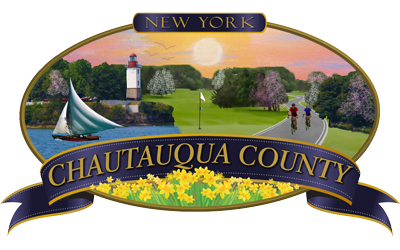MAYVILLE, N.Y.:-- The Public Health Division of the Chautauqua County Department of Health & Human Services (DHHS) urges all Chautauqua County residents and visitors to educate themselves about Harmful Algal Blooms (HABs) and to be cautious when swimming, boating, and fishing. In New York, HABs occur most frequently in the mid to late summer months but can occur at any time of the year. Small bloom conditions can change rapidly due to changes in weather and lake currents. Larger blooms will likely persist throughout the summer once they become established.
- Chautauqua Lake: Small, localized blooms have been observed.
Know It. Blue-green algae, also known as cyanobacteria, are naturally present in lakes. Nutrient rich runoff from surrounding land, warm water temperature, and sunshine encourages blue-green algae growth. With the right conditions blue-green algae forms blooms which may appear as floating “rafts” or scums on the surface of the water, these blooms are known as Harmful Algal Blooms (HABs). Be alert and watchful for blooms which may resemble “pea soup” or have a paint-like appearance with strong colors including blue-green, green, yellow, white, brown, purple, or red. Blooms are more likely in nearshore areas than open water areas.
HABs present a public health risk because they can release toxins which may be harmful to human and animal health. People and pets can be exposed to toxins by contact (touching, swallowing, and inhaling water droplets) with HABs during water recreation activities, through surface water use around the house, such as watering gardens, and through improperly treated drinking water. Key municipal water treatment facilities in Chautauqua County do test for toxins in their water when blooms occur near their intakes.
Avoid It. Christine Schuyler, Chautauqua County Director of Health and Human Services, said, “Not all blooms are hazardous, but the Health Department recommends taking the following precautions:
- When swimming, wading, or boating, avoid areas with blooms or surface scums, or water that is noticeably discolored. This applies to everyone - adults, children, and pets.
- Don’t fish or eat fish caught from areas with blooms or surface scums, or water that is noticeably discolored.
- Pay attention to beach closures, advisory signs, press releases, and websites. Never swim at beaches that are closed.
- Never drink, prepare food, cook, or make ice with untreated surface water, bloom or no bloom.”
If people or pets are accidentally exposed to a bloom use clean water to rinse off as soon as possible. Consider medical attention if people or pets have symptoms including diarrhea, nausea or vomiting, skin irritation, and allergic reactions or breathing difficulties after exposure to surface waters with HABs.
New York State and Chautauqua County have active programs aimed at reducing the amount of phosphorus and nitrogen entering streams and lakes. Watershed management plans have been developed for several lakes in Chautauqua County, including Chautauqua and Findley. As recommendations in the plans are implemented, improved water quality will follow, but it may take years to see improvements.
The NYS Department of Environmental Conservation and Department of Health investigate HAB reports, sample blooms for toxins, and conduct research to learn more about HABs and toxin production.
The Chautauqua County Health Department monitors permitted bathing beaches for HABs and the indicator bacteria E. coli. To best protect the public from possible illness, beaches are closed when the water exceeds bacteria safety standards and/or HABs are identified. The current status of Chautauqua County permitted public beaches and website links to additional HAB information are available on the County Website at https://chqgov.com/environmental-health/beach-closings.
###

